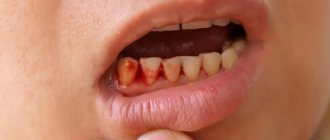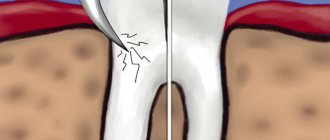Content
- Reasons for the development of pathology
- Which doctor should I contact if my tooth has chipped?
- Activities before visiting the dentist
- Microprosthetics
- Place a crown on a chipped tooth
- When is implantation necessary?
Tooth decay is an unpleasant event that requires immediate response. This can happen due to injury, untreated caries, brittle teeth and other reasons. Any chips, even small ones, mean a violation of the integrity of the enamel. That is, the tooth becomes vulnerable, infection can enter and the destruction of the crown part can continue. The patient begins to feel discomfort and pain when exposed to hot and cold temperatures, sweet and sour. The sharp edge of the chip injures the soft tissue of the gums during chewing, and bacteria penetrating into the wound cause inflammation. To restore your tooth and avoid negative consequences, you should immediately make an appointment with a specialist.
What to do if part of a tooth breaks off?
Visit a dental clinic as soon as possible after your injury. To completely restore damaged tissue and prevent the situation from getting worse, you need to act quickly. If a similar misfortune happens to a person nearby, he may need first aid.
First aid
In case of chipped teeth, specialized medical care is required, but in the first minutes after the injury, you can take a number of measures on your own. Rinse your mouth with warm water (use boiled water) to remove pieces of food and enamel particles. If the gum is damaged and bleeding occurs, apply a sterile bandage to the wound. To reduce pain and swelling, you can cool the tissues surrounding the injured area with ice or a cloth soaked in cold water. If pain causes significant discomfort, take an analgesic (a group of non-steroidal anti-inflammatory drugs).
Therapy at the dental center
To restore the healthy appearance of teeth, dentists use various restoration methods. If there is a minor chip of the enamel, composite materials are used that harden when exposed to light. From the same materials, the doctor creates a dental inlay, which is then attached to the surface of the tooth with glue if the dentin is damaged due to chipping.
Dental inlays are microprostheses, so their creation requires a pre-made impression. But in some clinics it is possible to make a composite inlay in less than a day. Thanks to this, the time spent on treatment is significantly reduced, and the patient stops experiencing pain much faster. This is especially important if there is an injury to the front teeth, and it is also necessary to restore the aesthetic appearance of the dentition.
Veneers are special microprostheses made of various materials (most often ceramics) that help quickly and efficiently correct chipped front teeth on their outer side. Minor chips of the molars are corrected with fillings, and sharp edges of the chip line are smoothed by grinding.
If the pulp is injured, the doctor performs an intervention called depulpation. It helps avoid inflammation and relieves pain. In such a situation, the tooth is restored using a pin. This device reduces the pressure exerted on the injured tooth and prevents its further destruction.
Chipped molars
The method of restoration of molars for chipped teeth is chosen by the dentist individually and depends on the location and degree of injury. Chips on the inside of molars are eliminated by installing fillings, and on the outside, damage is restored using composite materials. It is very convenient to correct damaged lateral teeth by installing metal-ceramic crowns. This material is very durable and can withstand significant loads when chewing food.
Chipped front teeth
If a front tooth is chipped, patients also suffer from psychological discomfort. If the frontal part of the dentition is affected, people may experience difficulty smiling and talking with others, and over time, speech distortions and facial expression disturbances may occur. Therefore, if a tooth is chipped, it is very important to visit the dentist on time.
If the enamel and dentin are damaged when a front tooth is chipped, a filling is installed and the sharp edges of the chip line are polished. When the pulp chamber is injured, the doctor performs depulpation and then fills the tooth (sometimes installing a pin). In some clinical situations, the use of microprostheses (veneers and lumineers) or composite dental inlays is required.
Enamel chip
Enamel is one of the hardest tissues of our body, but despite this, it requires constant and careful care. It is important to monitor its safety and remember the factors that contribute to its destruction. Cracks in enamel can occur due to excess consumption of carbohydrates, excessive consumption of solid foods, poor personal hygiene and bad habits. If after the formation of a chip or crack the dentin is not damaged, people are in no hurry to see a dentist due to the almost complete absence of symptoms. Minimal discomfort in the oral cavity is also a reason to visit a doctor, this way you can avoid many negative consequences and prevent the destruction of dental tissues.
Dentin chip
Dentin is the part of dental tissue located under the enamel that protects the nerve and pulp chamber. In terms of hardness, it is somewhat inferior to enamel. If a tooth is moderately chipped, destruction of dentin is possible, which is why the pathological process penetrates into the pulp chamber. When dentin is damaged during a tooth chip, the sensitivity of the damaged tooth sharply increases (hyperesthesia) when consuming hot, cold, sour, etc.
Chip exposing the pulp
If the pulp chamber is damaged, sharp pain occurs, which is poorly relieved with painkillers. It is recommended to visit a dentist as soon as possible. The doctor removes the pulp, cleans all the canals, removes the nerve, and then begins to restore the injured tooth. We invite you to visit our dentistry! We provide dental services near the Krasnye Vorota, Baumanskaya, Tretyakovskaya metro stations, as well as Novokuznetsk.
Reasons for the development of pathology
Damage can be caused by several direct or indirect factors. Determining the cause is an important aspect for proper treatment. Among these factors:
- Mechanical damage due to trauma.
- Chipping due to bad habits (biting nails, pens, and other objects not intended for this purpose).
- Reduced acidity of the oral cavity, which negatively affects the strength of enamel.
- Bite defects.
- Dental pathologies that have not received treatment.
- Remineralized enamel.
- Hormonal imbalances, changes during pregnancy.
- Frequent consumption of excessively hot or cold foods.
- Night grinding of teeth.
Possible causes of chipping
Caries is one of the most common causes of enamel destruction. In the case of eights, the risk of developing carious processes will be significantly higher, which is primarily due to their anatomical features and problematic growth. The sixth molars often grow crookedly and put pressure on their “neighbor”, and due to the dense gingival hood on top, this whole process is accompanied by inflammation and even suppuration of the mucous membrane.
This is the very last tooth in the row, it has the largest and widest crown, and its growth process can last for years. Bacteria inevitably accumulate in places that are difficult to clean, including under the gums, and plaque and deposits form.
Among other possible causes of damage, dental experts identify acute demineralization of hard tissues due to vitamin deficiency, systemic diseases, and weakened immunity1. Another possible reason is constant traumatic impact due to malocclusion, incorrectly installed filling, crown or prosthesis, due to bruxism - involuntary grinding of the jaws during sleep, which leads to pathological abrasion of the enamel.
Regardless of what exactly triggered the injury, you should seek advice from a specialist as soon as possible. The damage itself and the cause of its occurrence must be eliminated, otherwise the defect can lead to the development of complications.
Caries is one of the most common causes of enamel destruction
Activities before visiting the dentist
Depending on the extent of the damage, the patient may feel discomfort from increased sensitivity and pain. If a sharp edge is formed after the chipping, it will scratch the gum, tongue, and cheek. Such damage is a favorable environment for infection. The sharp edge must be isolated as soon as possible. A tooth that has lost full enamel protection is also vulnerable to infection.
While waiting for a visit to the dentist, the patient can take a number of actions to minimize negative consequences:
- Do not put any pressure on the affected tooth or chew hard food on its side.
- Thoroughly clean the chipped area, avoiding the accumulation of food debris and plaque.
- Rinse with a soda solution (you can add iodine and salt).
- If your chipped tooth hurts, you can take a pain reliever.
PROMOTION
Hygienic teeth cleaning
2000 rub.
Microprosthetics for tooth restoration
To restore the aesthetics and full function of a damaged tooth, restoration is used. If the chip is small, the problem can be solved using composite materials. For more significant damage, microprosthetics would be an excellent option. Inlays, which serve as microprostheses for restoring teeth, are made from composite materials based on an impression. They are durable and aesthetic, and are widely used in modern dentistry.
Micro-prostheses also include veneers. These are thin plates that are attached from the outside to the prepared teeth (in the frontal zone of the dentition, covering the front part and lower edge of the tooth). Veneers are also made from impressions and are effective in correcting most aesthetic problems. The plates are mainly made of ceramics and zirconium dioxide.
If the injury affects the pulp, the specialist treats the canals, and then fills or installs a microprosthesis.
Myth four: electric brushes and irrigators loosen fillings
Modern technologies have brought a lot of doubts and worries into human life. For example, people believe that active dental care using electric brushes and irrigators can ruin the situation with fillings.
“Here you need to know that a similar situation took place, but in a very short period of time. Then two factors coincided: the first composite materials with not the best physical and chemical properties were on the market, and ultrasonic toothbrushes had just appeared, which operated at a wave frequency at which really old fillings swayed,” says Ilya Antonov.
Manufacturers of brushes responded very quickly to this problem, changing the frequency of the oscillation wave to a more gentle one without losing the quality of cleaning, plus the properties of composites improved, and for a long time, for reasons related to the use of electric brushes and irrigators, fillings do not fly out, says the dentist.
Chew less often! Do I need to remove wisdom teeth and is fluoride toothpaste harmful? More details
Installing a crown on a chipped tooth
In case of significant injuries, if it is impossible to restore the crown part of the tooth, a new tooth can be obtained using prosthetics. The prosthesis - crown - is fixed on the root of the tooth if this part remains healthy and strong. Different types of crowns are used depending on the material of manufacture:
- Metal ceramics are the most inexpensive option. The design is durable due to the metal base, and aesthetic due to the ceramic layer. Such dentures become an ideal option for budget restoration of teeth in the chewing area. Installation of metal ceramics in the frontal area is possible, but the tooth will not look natural due to the lack of transparency.
- Zirconium dioxide is a modern high-tech material that has both the strength and aesthetics of natural teeth. Such crowns are made using computerized technology and are practically indistinguishable from natural teeth in appearance. They refract light correctly and have a certain degree of transparency, similar to tooth enamel.
- Ceramic crown. This option is only suitable for the front teeth, since the structure is not strong enough to withstand the full chewing load. Ceramics look very aesthetically pleasing.
When is implantation needed?
Implantation is required if the root part of the tooth is damaged and cannot be used as a support for a prosthesis. This can happen when the side wall of the tooth is broken (below the gum level), deeply damaged by caries, root fracture, etc. In these cases, the tooth is completely removed and replaced with a titanium rod - an implant. Crowns are also placed on implants. These are metal ceramics and zirconium dioxide; ceramic prostheses are not used due to their high fragility.
Wisdom teeth diseases
Most often, third molars suffer from caries, since due to the inconvenient location of the “eights” in the mouth, it is extremely difficult to take good care of their hygiene. A carious cavity usually occurs in an area that is difficult for the dentist to reach, so treatment is not always possible. If the doctor understands that it will not be possible to get close to the affected area and fill the tooth properly, he suggests removing the third molar.
At the same time, it is important to understand that you should not delay going to a specialist if you notice any problems with the G8. Untreated caries may well develop into pulpitis and even periodontitis, which will require a definitive tooth extraction.
Prevention of dental diseases
A number of simple steps will help the patient keep his teeth healthy for as long as possible and reduce the likelihood of diseases:
- Careful hygiene, brushing teeth at least twice a day.
- Using dental floss and rinsing with special solutions.
- Attention to the condition of soft tissues and gums.
- Timely visit to the dentist if alarming symptoms appear, preventive examinations twice a year.
How to pull a tooth at home without pain
How to relieve toothache at home










